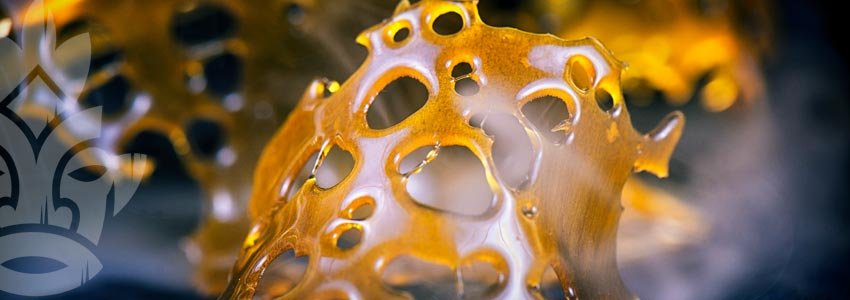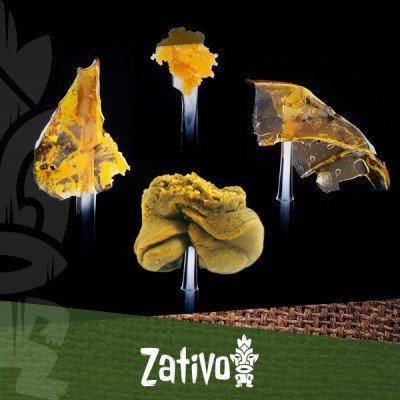Don't have an account?
Register NowYou have to add to cart at least 5 bottles or any program to make checkout.
- BlogTypes of Cannabis Concentrates
Types of Cannabis Concentrates
Published: July 3rd, 2017
Categories:
Cannabis Info
Understanding The Differences Between Shatter, Budder, Oil And More
At one time or another, the only types of cannabis most consumers could get their hands on came in the form of flower, old-school pressed hash or inconsistently baked edibles. In today’s ₂ 1st century world of cannabis innovation, concentrates have emerged as one of the most popular new methods for consumption.
WHAT ARE CONCENTRATES?
So, what exactly are concentrates? With a seemingly endless number of textures and hues to choose from, what makes one variety different from the next? As a term often invoked in reference to “dabbing,” concentrates are created by isolating cannabinoids, terpenes and other important compounds from cannabis plant matter. This procedure is carried out using a number of diverse methods. The two main categories of concentrates originate as solvent and solventless extracts, which both harness the same cannabinoids using different processes.
WHY ARE CONCENTRATES IMPORTANT?
There are a number of reasons why concentrates are an optimal formulation for ingesting cannabinoids. To start, concentrates contain significantly higher cannabinoid levels than flower, reaching staggering concentrations up to 90%. Concentrates allow consumers to intake greater amounts of THC and CBD without having to smoke as much.
For some inexperienced users, concentrates may conjure imagery of serious stoners dabbing huge amounts of wax and oil to achieve augmented psychoactive effects. While there is a lot of recreational value in dabbing, it is not the only way concentrates are used. What’s more, not all concentrates contain the psychoactive cannabinoid THC. In fact, some extraction methods have made it easier for individuals to receive high concentrations of beneficial CBD, without altering their state of mind.
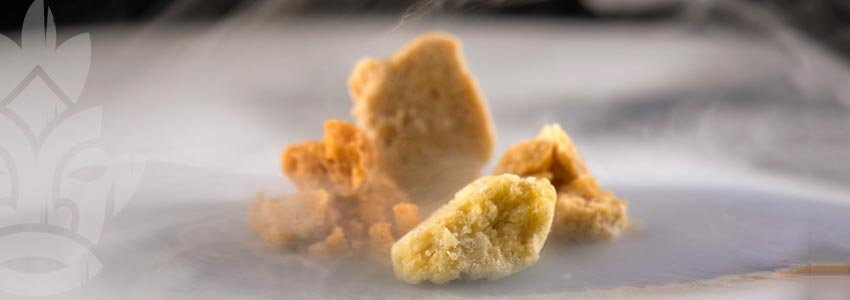
SOLVENT EXTRACTIONS
Hydrocarbon extraction using solvents is a process mostly carried out by cannabis extraction technicians. The process involves directing heat, pressure and chemicals to harness compounds with the utmost precision. Technicians often come with backgrounds in cannabis science or cultivation and have experience working in laboratories.
Put simply, solvent-based cannabinoid extraction takes plant matter and reduces it only to its most beneficial ingredients. Unrewarding chlorophyll, fats, waxes and other plant matter is separated away, as are lingering additives and microscopic contaminants.
CO₂ EXTRACTION
CO₂ extractions, formally known as supercritical fluid extractions, are an optimal way to isolate essential compounds from cannabis plant matter. This method is to thank for oil vaporizer cartridges, which usually appear in dark amber coloured oils. The CO₂ extraction process is the “cleanest” solvent technique around, leaving nothing harmful in its wake. However, CO₂ extraction methods are more time consuming and expensive. Additionally, the resulting substance is less terpene-enhanced than its counterparts.
BHO AND PHO
If you are wondering which concentrates work best for dab rigs, look no further than BHO and PHO, standing fore Butane Hash Oil and Propane Hash Oil respectivly. Like CO₂ extraction, butane and propane strip cannabinoids from plant matter. The difference with these methods is that extracts must be purged of solvent residue.
Unfortunately, there is almost always some leftover remnant which is why these methods are somewhat less safe than CO₂ or solventless extractions. BHO and PHO concentrates that have undergone extensive testing will likely NOT contain toxic solvent levels and are safe to ingest.
What BHO and PHO have over supercritical fluid extractions are higher concentrations of terpenes. These aromatic hydrocarbons offer more than just pleasant scent of pine, clove, lemon - they also contain therapeutic potential and can boost the efficacy of both THC and CBD. Some CO₂ oils have significant levels of terpenes since they are harvested separately from cannabinoids and later infused.
“RICK SIMPSON” OIL
Discovered by the man himself, Rick Simpson oil employs alcohol as a solvent. Using this approach, cannabis plants are ground and then soaked in high-proof alcohol for just a short while. The alcohol is infused with the active ingredients, allowing plant matter to be filtered out.
Like BHO and PHO, Rick Simpson oil must be thoroughly purged in order to be safely ingested. The resulting oil is a tar-colored liquid, which can be consumed by mouth or in dermal applications. RSO is often invoked for its medicinal value - in fact, Rick Simpson innovated the method as a means to treat his skin cancer. RSO continues to be a steadfast, smokeless method for many individuals seeking therapeutic relief.
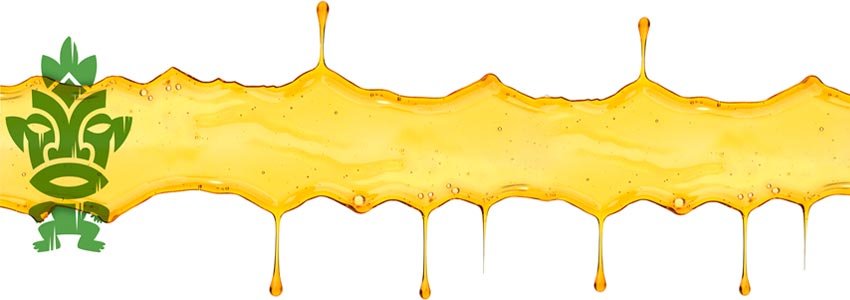
SOLVENTLESS CONCENTRATES
Despite the prevalence of solvent-based concentrates around the world, solventless concentrates highlight cannabinoids in their most unadulterated form. The following techniques/conentrates can be explained with a basic understanding of trichomes. These glandular hairs appear on cannabis flowers and contain cannabinoids, terpenes and other compounds from its resin-filled heads.
These heads are nearly microscopic, but can be isolated without using solvents at all! The process is easier said than done, however, and is much more time consuming (though less costly) than BHO or CO₂ production.
A “natural” form of solventless concentrate you may have heard of is kief. Known by many consumers as the collected goodies at the bottom of a handy grinder, kief is made up primarily of trichomes, along with bits of other plant matter.
True solventless concentrates are made up almost exclusively of cannabinoids and therefore are known as “full melt” concentrates. Full melt entails that the concentrate leaves behind no residue and retains the original integrity of the cannabinoids.
ICE WATER HASH
Ice water extractions - as you may have guessed - incorporate ice and water to separate resin heads from trichomes. Once isolated, the mixture is thoroughly filtered through different sized screens to separate the “good stuff” contaminants such as plant matter. In order for the ice water hash to be usable, it must be dried and cured for maximum effect.
SHO/ROSIN TECH
A unique DIY method for producing solventless hash oil (SHO) is the Rosin Tech method. The only materials required are a ceramic hair straightener, parchment paper, and a surface to collect the resulting oil. When heat and pressure from the straightener are applied to trichomes, the resin heads will separate. There are more refined methods for this procedure, but only heat and pressure are required to achieve success. This method has boomed in popularity by amateurs since it doesn’t involve the danger of solvents or expensive equipment.
HASH
Hash is one of the oldest methods of concentrate creation. Traditional pressed hash takes kief and compresses the resin glands together. This results in dense clusters or bricks which sustain higher THC levels than flower, but lower than solvent-extracted concentrates. As more streamlined methods have become available over the years, this style of hash has given way to new production techniques.
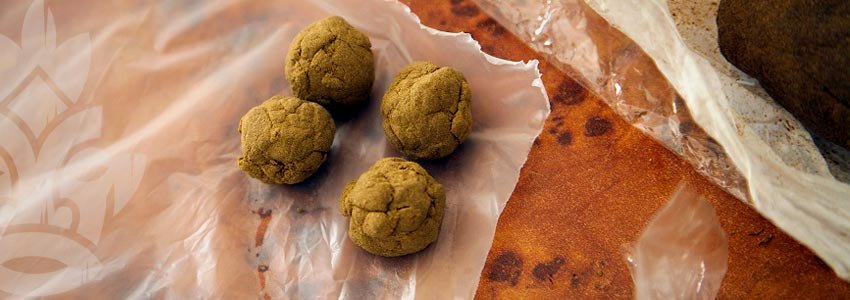
CONSISTENCY BREAKDOWN
A question on many people’s minds regarding concentrates is the difference in physical consistency between products. It all comes down to personal preference, but there are some distinctions between each variety.
OIL
Most oil concentrates with low viscosities come from CO₂ extractions. As vaporization has become a fast-growing alternative to smoking flower, oil is the ideal method for vaping without clogging the device. A myth surrounding some oils is that the darker the color, the weaker it is. This is not necessarily true - some oils retain impressive levels of THC, but have not been filtered of plant matter and therefore are darker in hue.

CRUMBLE
Crumble (an apt descriptor) is usually pre-purged to hold onto terpenes and taste better. The solid consistency of crumble makes it adaptable to different methods of consumption. It can be vaporized, dabbed or smoked with flower, depending on what accessories you have.
WAX
Comparing wax and oil, the former takes on a stickier consistency that is perfect for using with a dab rig or for adding atop flower. Wax sticks to dab tools, making it an easy method for first-time dabbers. Just be careful not to get it on your hands since it can be hard to remove!
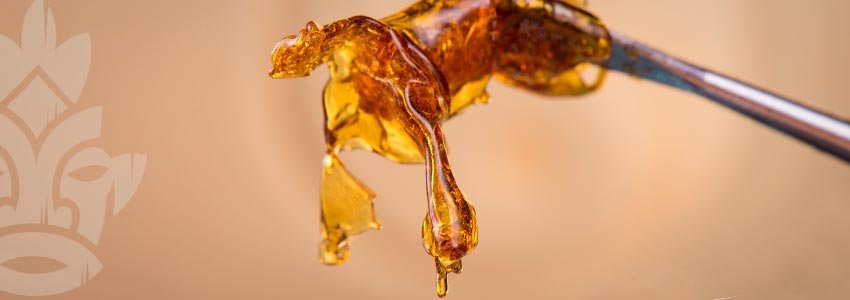
BUDDER
Concentrates appear on a spectrum of consistencies ranging from thin liquids to thicker, glassier substances. Budder remains somewhere in between wax and crumble. While less sticky than wax and more malleable than crumble, budder is the ideal method for some connoisseurs. Budder can be a bit more difficult when it comes to sticking to a tool but features a stronger presence of terpenes.
SHATTER
Perhaps the most visually striking outcome of BHO and similar extractions is shatter. Comprised of a hard, thin shape, this concentrate makes for sleek and potent dabbing. A couple minutes spent patrolling on social media will reveal the satisfying visual art of watching shatter vaporize.
What is clear from the various methods above is that physical texture has less to do with the value of the product than the method in which cannabinoids were extracted. Each type of concentrate showcases different outcomes of taste, THC concentration, texture and more. So what are you waiting for? It's high time to explore the wide world of concentrates!
